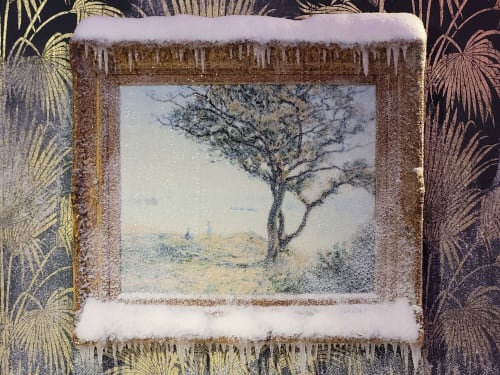Samedi 23 décembre 2023, le musée de l’abbaye de Saint-Claude propose une nouvelle exposition temporaire intitulée « Paysages gelés » sur le fascinant paysage hivernal de la montagne servi par une cinquantaine d’œuvres d’époques différentes d’une trentaine d’artistes.
« Cette exposition a été imaginée l’année dernière avec Amélie Lavin (conservatrice en chef au Muceum de Marseille) et Corsin Vogel (artiste, enseignant-chercheur et docteur en sciences) qui a déjà réalisé une exposition il y a deux ans à Evian sur la « Montagne, fertile» explique Valérie Pugin, directrice du musée de l’Abbaye à Saint-Claude. Installée tel un cheminement depuis le sous-sol dans la partie archéologique, puis sur chaque niveau jusqu’au deuxième étage, cette superbe exposition qui allie peinture, sculpture, photographie, videos et installation sonore, décline trois thématiques : la représentation de la montagne au 19e siècle, la matérialité de la neige, du gel et leur dangerosité, ainsi que la manière dont l’homme a abordé la montagne et doit réagir face au réchauffement climatique.
Comment la montagne et l’hiver ont été appréhendées ?
Ainsi, au sous-sol, Corsin Vogel s’est imprégné du lieu pour adapter le texte écologiste avant l’heure « Pour qui sonne le glas » du poète John Donne écrit en décembre 1623… et réaliser une création intitulée « Pour qui sonne la glace » qui s’appuie sur une installation sonore très prenante. Au rez-de-chaussée, plusieurs tableaux permettent de commencer à appréhender la façon dont les peintres du 19e siècle ont représenté l’hiver : la neige, les arbres dénudés… à la montagne, mais aussi en plaine. Laurent Pernot a d’ailleurs réalisé des « tableaux givrés » dont quelques-uns sont à découvrir.
-
Saturday, December 23, 2023, the museum of the abbey of Saint-Claude proposes a new temporary exhibition entitled «Frozen landscapes» on the fascinating winter landscape of the mountain served by fifty works of different eras by thirty artists.
« This exhibition was imagined last year with Amélie Lavin (Chief Curator at the Muceum in Marseille) and Corsin Vogel (artist, teacher-researcher and doctor of science) who already made an exhibition two years ago in Evian on the «Mountain, fertile» explains Valérie Pugin, director of the Abbey Museum in Saint-Claude. Installed as a path from the basement in the archaeological part, then on each level up to the second floor, this superb exhibition that combines painting, sculpture, photography, videos and sound installation, offers three themes: the representation of the mountain in the 19th century, the materiality of snow, frost and their dangerousness, as well as the way in which man approached the mountain and must react to global warming.
How were the mountains and winter approached?
On the basement floor, Corsin Vogel has adapted John Donne's early environmentalist text "Pour qui sonne le glas" (For whom the bell tolls), written in December 1623... and created a work entitled "Pour qui sonne la glace" (For whom the ice tolls), supported by a highly engaging sound installation. On the first floor, a number of paintings provide an introduction to the way in which 19th-century painters depicted winter: snow, bare trees... in the mountains, but also on the plains. Laurent Pernot has also produced a number of "frosted paintings", some of which are worth a look.

